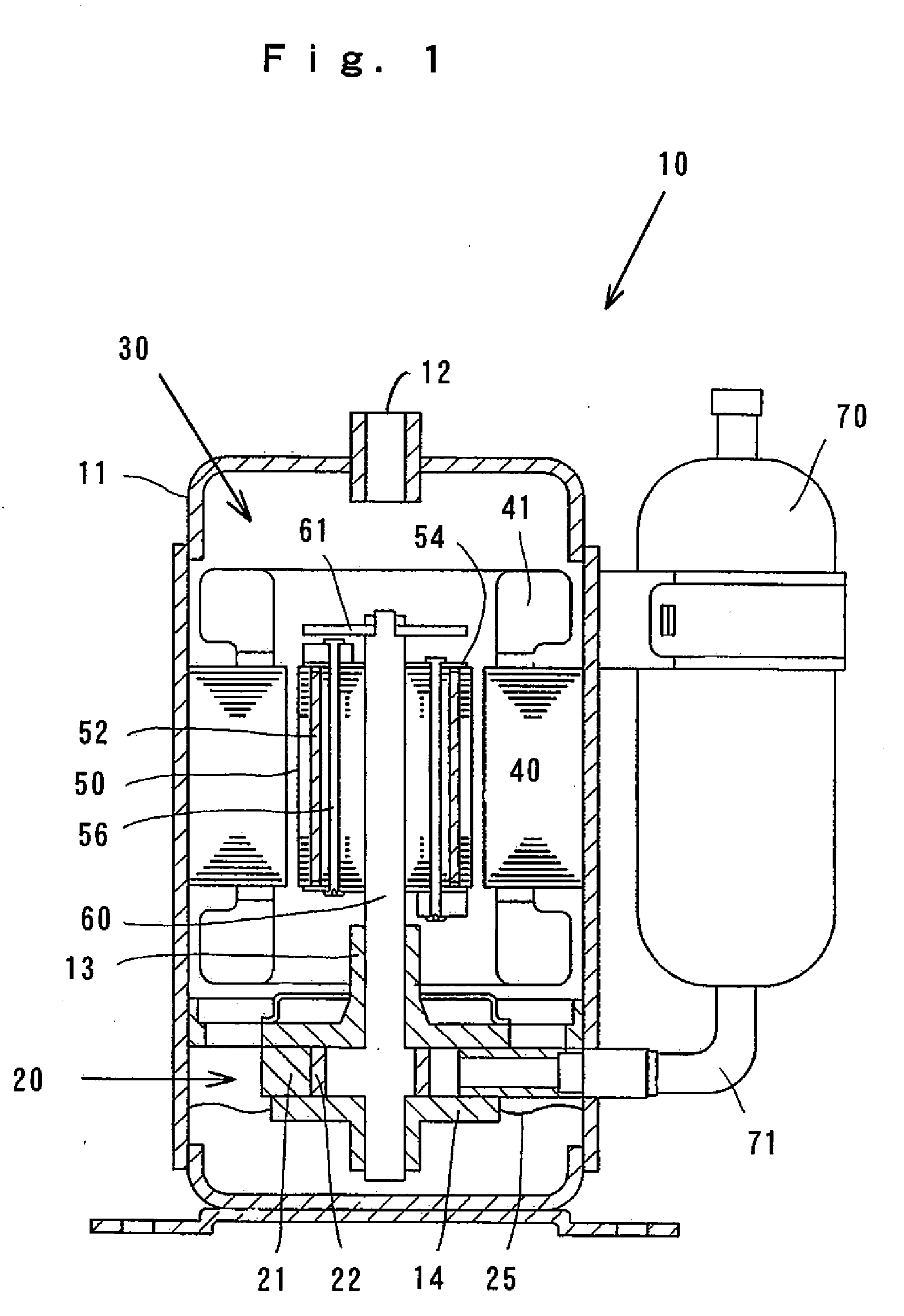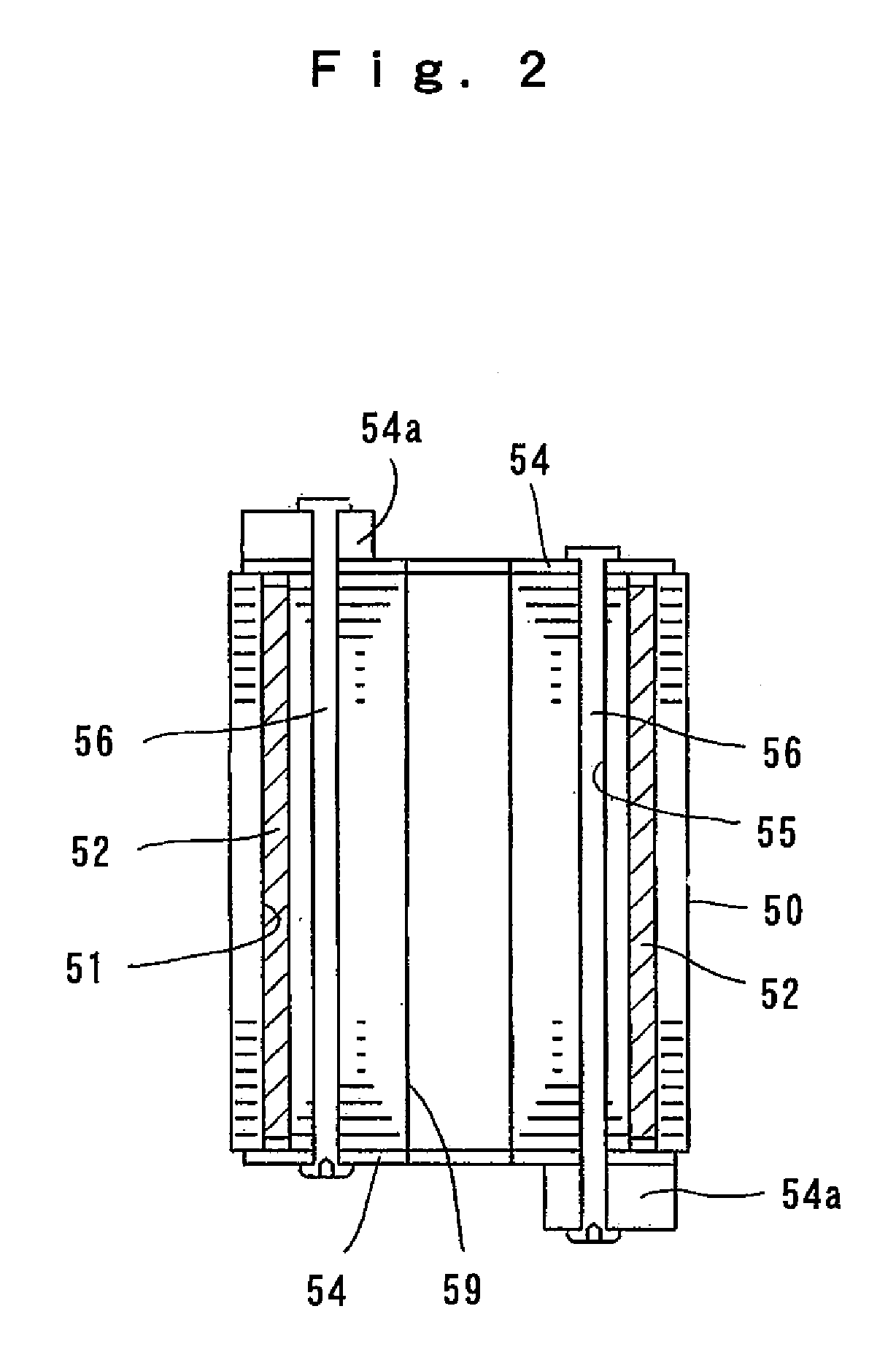Permanent magnet rotating machine
a permanent magnet, rotating machine technology, applied in the direction of magnetic circuit rotating parts, magnetic circuit shape/form/construction, piston pumps, etc., can solve the problems of motor performance deterioration, increased iron loss caused by harmonic components, noise and vibration, etc., to reduce the influence
- Summary
- Abstract
- Description
- Claims
- Application Information
AI Technical Summary
Benefits of technology
Problems solved by technology
Method used
Image
Examples
first embodiment
[0074] Next, the construction of the rotor 50 of the permanent magnet motor 30 of the first embodiment will be explained in further detail with reference to FIGS. 3 and 4. FIG. 3 is a cross section of the stator 40 and the rotor 50 as viewed from the direction perpendicular to the axial direction. FIG. 4 is a cross section of the rotor 50 as viewed from the direction perpendicular to the axial direction.
[0075] In this embodiment, the rotor 50 having four poles (two pairs of poles) and the stator 40 having the construction shown in FIGS. 1 and 3 are used. This is the same with other embodiments in this invention which will be described below.
[0076] In the rotor 50, main magnetic poles and auxiliary magnetic poles alternate in the circumferential direction when viewed in cross section (perpendicular to the axial direction). Magnet insert holes are provided in the main magnetic poles.
[0077] In the following description, the main magnetic poles are represented by main magnetic poles ...
second embodiment
[0134]FIG. 5 is a cross section showing a rotor 150 of a permanent magnet motor according to a second embodiment.
[0135] A rotary shaft 160 has an outside diameter larger than the bore diameter of a rotary shaft insert hole 159 and is inserted into the rotary shaft insert hole 159.
[0136] A magnet insert hole 515a1 is provided in the main magnetic pole [a] and bow-shaped in cross section (taken in a direction perpendicular to the axial direction). The bow-like shape is formed to bulge in the radially inward direction (or to be recessed in the radially outward direction).
[0137] A permanent magnet 152a having a bow-shaped cross section is inserted into the magnet insert hole 151a1, typically by a clearance fit, such that a gap is formed between the permanent magnet 152a and the magnet insert hole 151a1.
[0138] Bridges 153a1, 153a2 are provided between outer end walls 151a2, 151a3 of the magnet insert hole 151a1 and the outer circumferential surface (150DA, 150AB in FIG. 5) of the rot...
third embodiment
[0157]FIG. 6 is a cross section showing a rotor 250 of a permanent magnet motor according to a third embodiment.
[0158] A rotary shaft 260 has an outside diameter larger than the bore diameter of a rotary shaft insert hole 259 and is inserted into the rotary shaft insert hole 259. Magnet insert holes 251a1, 251a4 are arranged in V-shape in the main magnetic pole [a] of the rotor 250. The V-shape is formed to bulge in the radially inward direction (or to be recessed in the radially outward direction) of the rotor 250. A bridge 253a1 is provided between the magnet insert holes 251a1 and 251a4 (in the central region of the main magnetic pole [a]).
[0159] Permanent magnets 252a1, 252a2 having a rectangular cross section (taken in a direction perpendicular to the axial direction) are inserted into the magnet insert holes 251a1, 251a4. Projections 251a3, 251a6 are formed on the magnet insert hole 251a1 and serve to position the permanent magnets 252a1, 252a2. Thus, spaces (non-magnetic re...
PUM
 Login to View More
Login to View More Abstract
Description
Claims
Application Information
 Login to View More
Login to View More - R&D
- Intellectual Property
- Life Sciences
- Materials
- Tech Scout
- Unparalleled Data Quality
- Higher Quality Content
- 60% Fewer Hallucinations
Browse by: Latest US Patents, China's latest patents, Technical Efficacy Thesaurus, Application Domain, Technology Topic, Popular Technical Reports.
© 2025 PatSnap. All rights reserved.Legal|Privacy policy|Modern Slavery Act Transparency Statement|Sitemap|About US| Contact US: help@patsnap.com



